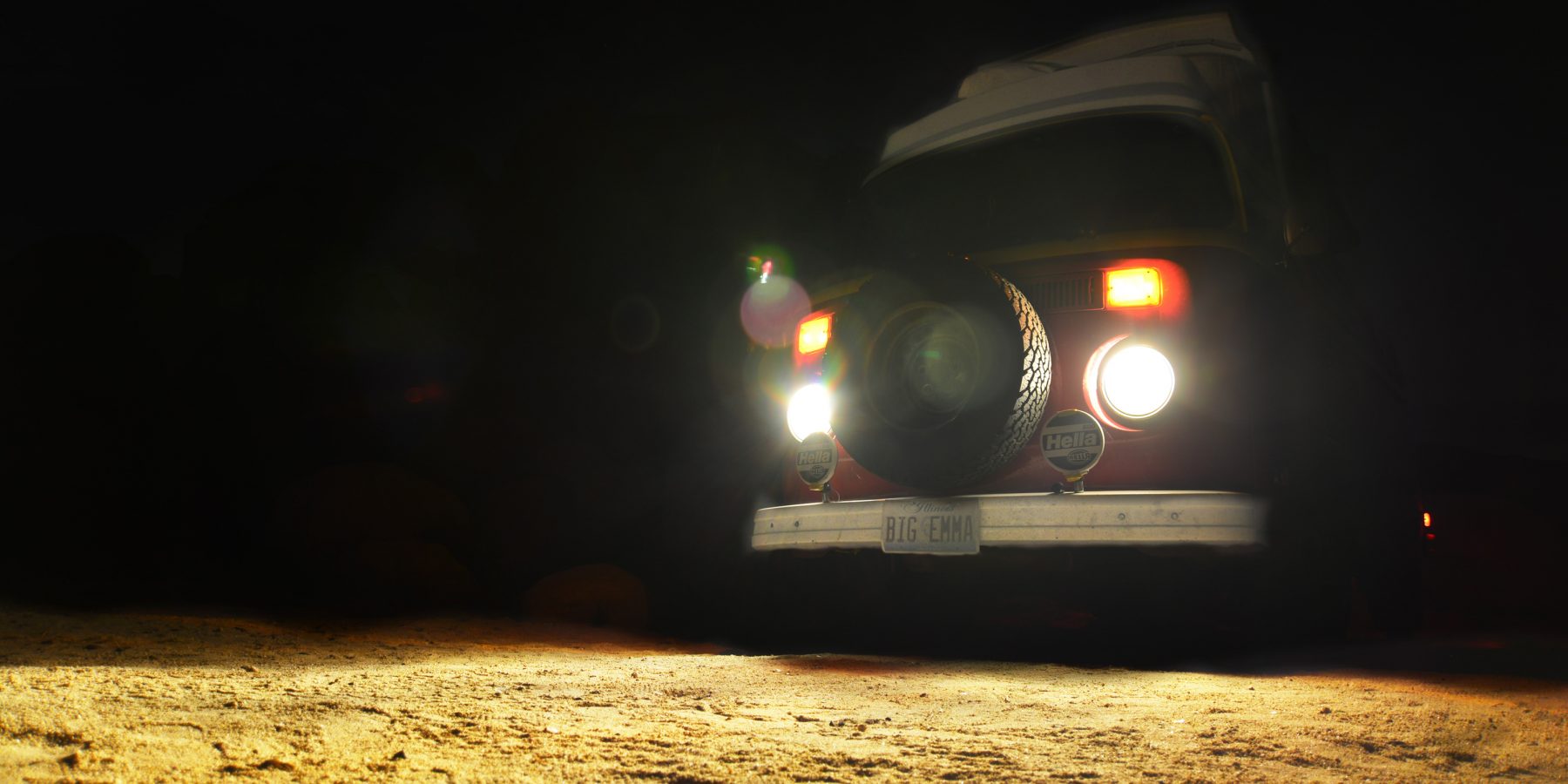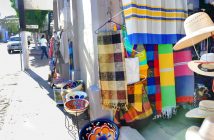This week, we finally head to Mexico. What will it be like? Turn on the headlights with us and take a look at our expectations – from culture to language to safety to Internet – and how our trip will change when we enter Latin America.
Before embarking on something new, I’ve heard it is healthy to reflect on your expectations. What do I think it will be like? What will I experience? Are my expectations realistic, or are they based on stereotypes?
This week, we cross the border into Mexico, and we expect our trip to drastically change. But what will that entail, exactly? What will Mexico be like? What makes us think it will be so radically different?
A new country, a new culture: a challenge of the fantastic sort
After crossing the border at Tecate, we will suddenly be plunged into a whole new world. We are foreign travelers, not locals like we are now in the USA. Sure, Sven is actually German, but if you’ve ever spoken to him, you would guess he was born and raised in the good old US of A. This is a place where we feel at home, comfortable with the country and the culture, and we can estimate what to expect of people and what they will think of us; we’ve learned where we can park without bothering anybody, we know the common do’s and don’ts of social interaction. Once we get to Mexico, this will not be something we can take for granted.
We will be the gringos, and people can immediately identify that we come from somewhere else. We will no longer be a part of the ethnic majority. You will hear it in our speech, see it in our faces and written on our license plate. I imagine we will feel much more like tourists than we do now. A plain and simple fact is: origin is something we will never be able to hide.

Big Emma proudly proclaims her heritage in the Land of Lincoln.
However, it is also part of what makes a foreign place so enticing to us. A foreign environment, where you are constantly questioning the meaning of other’s actions and their interpretations of your own, is an environment of growth. It means you are constantly thinking about how to do even the simplest tasks in life. You are forced to rethink your own ideas about nearly every subject, and it is an almost constant stimulation. Although this means that life south of the border will be harder, we expect it to be a challenge of the fantastic sort.
Less vanlife, more travel?
One of the challenges, aside from those brought on by the cultural and language barriers, will be the simple routine of living in a van. We have gotten pretty good at this vanlife thing here in the States. We have developed a network of people, both van-dwellers and non-nomads, we know where to look for good camping. We know where we feel safe and where we do not. How will this change, though, south of the Mexican border?
We expect life to be less about vanlife and more about travel. Yes, our trip was about travel in North America, too. But it was also a trial run living in our van, getting to know Big Emma better. Now, we know all of that (or so we think). Vanlife is much more of a thing in the US (and Australia, too, actually), and it is unlikely that we will meet many Mexican vanlifers, Mexicans who are digital nomads traveling around and discovering their country. It is much more likely that we will be meeting other foreign travelers. Everyone will be coming from somewhere, and everyone will be going somewhere.

A picnic for three in the wilderness. Will this be a common sight once we cross the border, or will we always have company?
This is hard to assess from our point of view now. What will this mean for us? We will be staying in a vehicle, not a hostel where it is easy to meet other travelers. Will we find ourselves on many lonely beaches, with all of the time in the world to just hang out and enjoy each other and the sunshine? Or will we, as another vanlifer said, “be so busy meeting people we will never get anything done”?
The Panamerican Highway, just like any other travel route, has its major stops, its highlights, the places that travelers tend to go to. When the roads that funnel travelers get thin, like up in Alaska, you are bound to constantly cross paths. We want to visit these places, and meet other travelers, but we also want to see the things that the guidebook doesn’t mention.
The locals and the language
The most important thing the guidebooks don’t mention is the people. Will we be able to meet local Mexicans, as we did all across the North American part of our journey? Will we find it is easier or harder to get in contact with them, will we be pushed aside into the tourist crowds?
Don’t get me wrong – I do not fear it will be harder to get to know Mexicans because they are Mexican. I fear it might be harder because we are not very good at Spanish yet. Although we are learning, we still have a long way to go before we can have deep, theoretical conversations with a stranger in Spanish. I’ll be lucky if I can tell someone about my Bus, and only if that someone is willing to speak very slowly and is patient with foreign-language learners.
What if we can’t bridge the gap?
There is no doubt about it, however: language will be the key to success in Latin America. But as much as we intend to perfect our Spanish, will we really be able to? Will we really have the discipline to learn another language to the extent we need to learn it? Or will we eventually give up, get stuck at a level that allows us to communicate what we need, but generally spend our time with other travelers, speaking English? Or, as I experienced in Indonesia, will many locals we meet in Latin America insist on speaking English with us (a situation that neither fosters my own language learning nor true cultural understanding – no matter how good the intentions are of the person who wants to help us by speaking my language instead of their own)? This, for us, is a very real fear.
And it is not just a language gap that will make meaningful interactions with locals a challenge, but the cultural gap as well. Will we be able to step well outside our comfort zones? Will the culture gap make meeting locals that much harder than in the USA? Will we be able to overcome stereotypes, false expectations, and prejudices enough to bridge the gap?
The topic on everyone’s minds: expectations regarding safety
And that gap is a large one. I would bet, for many of you reading this, one of the first things you thought when we mentioned going to Mexico was “Oh, I hope they will stay safe”.
More than any other country (including Venezuela, which is currently in such a state of instability that travel is completely inadvisable), people have been very concerned with our safety in Mexico. Famous for its recent drug wars and with horror stories like in Iguala – which involved 43 students disappearing mysteriously in 2014 – filling the media, it is no wonder that such strong stereotypes exist. We have met people who blatantly told us that we will get killed in Mexico. We also know people like my dad, who bought us a book about practical overlanding advice in Central America instead.
 And while most of the fears that the average Westerner seems to hold about Mexico have grown from many years of negative media, they are not 100% wrong, either. Safety is a concern while traveling in Mexico. It is something that all travelers should keep in mind – just like anywhere they go in the world. We will keep our doors locked, do our research, exercise common sense, and stick to daytime driving – but in between we have a whole lot of Mexico to explore.
And while most of the fears that the average Westerner seems to hold about Mexico have grown from many years of negative media, they are not 100% wrong, either. Safety is a concern while traveling in Mexico. It is something that all travelers should keep in mind – just like anywhere they go in the world. We will keep our doors locked, do our research, exercise common sense, and stick to daytime driving – but in between we have a whole lot of Mexico to explore.
In the face of so many concerns, it is important to remember that there are plenty of tourists in Mexico who come home in one piece, and many overlanders who never see a shred of violence. Personally, we have not heard of anyone doing this trip who has encountered a worse crime than things getting stolen out of their car. Although the Mexican drug wars are real, they rarely affect tourists. And – it is always important to remember – tourists can be targeted by violence in any country in the world. Many Germans are very concerned about safety in the United States, for example, because of our extremely liberal gun laws. So far, we haven’t gotten shot.
Watch out for cows
Safety concerns will surely affect our trip, if only for the reason that we are in unfamiliar territory as vanlifers. We might not be able to spend large amounts of time in very isolated places, like we love to do in the US. Instead, we may learn that the best places are the ones that are labeled in the traveling app iOverlander. We have heard of others who have said that they slept outside of police stations in some locations because it was the only safe place to camp in the area. Safety factors might limit us to which road we decide to take, or the perceived need to caravan with other travelers.

One of our favorite isolated camp spots on the Alaska-Canada Highway, up in Alaska.
In this respect, it is interesting that we will start our travels through Mexico on the Baja Peninsula. We have over 1000 miles of relatively lonely roads, deserts, and isolated beaches ahead of us. Baja, according to the Lonely Planet, is one of the safest states in Mexico. Concerning driving at night in Baja, something that every source has emphasized was not prudent, the Lonely Planet says, “Driving at night is not recommended due to the possibility of cows wandering onto the road”. If cows are what travelers should worry about at night, it seems no less safe than California’s Highway 1. Who knows? Despite all of our expectations, we might not even realize we had crossed a border if you discount the language thing. Baja, next to the Yucatan, is the most touristy place in Mexico. Maybe we won’t even notice the big differences until we reach the mainland, after we cross the Sea of Cortez to Mazatlán.
I have never traveled internationally with a companion like Big Emma before
It is hard to know what to expect of Mexico in terms of Big Emma. I have done a lot of traveling in foreign countries, but never in a vehicle, especially not one I own and want to temporarily import into over twenty countries.

Big Emma, being flamboyant.
Big Emma is a flamboyant Bus, and sticks out like a sore thumb everywhere she goes. Our colors make us noticeable, a factor that I personally love and that has been an advantage for us on our travels so far. She is the ice-breaker of our bunch, and it is often because of Big Emma that we meet the incredible people that we do. Kombis, as they call Volkswagen buses in Latin America (and Australia, for that matter), are very common in Mexico. They were produced there until 1994, and they are common cars for public transportation. Big Emma will not be so unique in Mexico (although the fact that she is an international road tripper probably will be). We have yet to discover what this will mean for us.
One thing it does mean is that general replacement parts are more common than in most other Latin American countries (except Brazil, where old-style VWs were produced right up until 2014). While this might be an advantage, we have a different kind of engine than the ones Mexico put in their buses. I actually have no idea how easy it will be to get parts if we need them, especially in rural areas. We carry a large number of spare parts, but of course, the one we need will not be one of the ones stuffed into our spare wheel well when the time comes. In addition to this, I have no idea how to say or even remotely describe the parts of my car in Spanish. The time it is most crucial will be the ultimate test of our growing language skills.
That thing called Internet

Phone reception is very important for our blog. Outside of cities, we generally rely on extending a mobile hotspot from our phone to our other devices. No reception means not a lot of blogging.
Another fear of ours is not having enough Internet access once we cross the border. We plan to get a country-specific SIM card in every country we go, giving us access to mobile Internet – if there is reception. We have heard that, on mainland Mexico, reception is just as good as it is in the States: good in cities and towns, and spotty in rural areas. On Baja, however, reception is rumored to be scarce.
We need Internet – often – to run our blog, and this may affect our work when we are in Baja. This is seriously troubling to us. Worst case, this could mean that you look at our website next week expecting something new and finding this here article instead, and posts on Instagram and Facebook will become less frequent. We might have to seriously reorganize our publication methods. But we also try to never worry about things that haven’t happened yet.

Another of our favorite in-the-middle-of-nowhere campspots, near Joshua Tree National Park in California. This one is extra-awesome because it has phone reception. Will we find places like these in Baja?
The “developing” world?
Crossing this border, we are filled with our expectations of entering the first country on our itinerary that is considered “the developing world” rather than a Western industrial country. These expectations range from local people to safety to phone reception, from language barriers to cows to purifying water. Being from another country, we cannot ever fully escape our expectations, no matter how hard we will try. But if living in Indonesia taught me anything, it is that a “developing” country is often much more developed than where I’m coming from, just in very different ways.
And that’s the reason why we go in the first place: we have no idea if this is what Mexico will be like for us – but we will never know until we find out for ourselves. So, we turn on our headlights and remain wary of cows. Stay tuned.
This is part two of our thoughts on turning our travels from the USA to Mexico. Check out part one here.





5 Comments
Be safe my loves!
Love you both. Be safe and happy.
Thank you Shameem! We’re doing our best. 🙂
Be safe and don’t worry. Everyone you encounter, in every country you visit will appreciate and admire what you are doing.
Thank you, Stephannie, we will do our best! I hope so too!